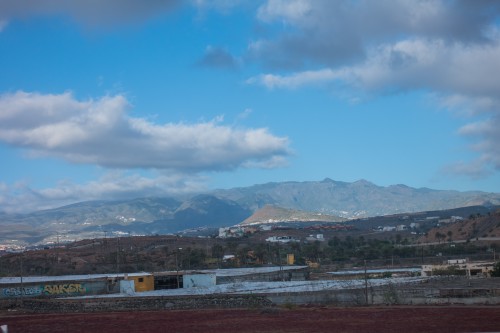
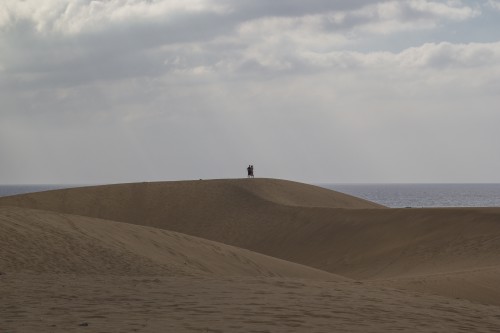
We woke up after our first quasi-normal night of sleep all trip; everything before was either over 10 hours or under 4. We opened up the window and it looked a little cold and windy outside. Starting to repeat habits, we went up to 7 and grabbed a donut and tea. We also had time to fill out one of the “review” forms that had been left in the room. We thought it was a good idea that they did this after 3-4 days, when there was still time to improve things on this same cruise, rather than for the next people. So we wrote a note about getting Matias his own pisco for the Patio Bar.
While waiting to disembark we checked in on the Fuerteventura saga. We’d reached out to a couple different agencies, and had been asking our guides if they knew of other guides on Fuerteventura. This morning we got something from Ignacio at Cantour, saying he might be able to arrange something, but that he’d confirm and get back to us. We couldn’t get off boat until around 8:20, and we (Justin) were a bit antsy. No one was there at 8:30, and we waited 5-10 minutes looking around. Just when we were about to email our guide Guillermo, we got a text from him – we just had to walk two minutes to exit the “secure” area of the port.
 |
 |
Guillermo first showed us on the car’s Navigation unit where we were going. He said that because of weather, and impending rain, that things might get moved around. His initial plan was that when it was most likely to rain, we’d be eating lunch in a cave. Our first scheduled stop was at the dunes in Maspalomas, then to the top of the island, and more from there. So we set off from Las Palmas de Gran Canaria, in the far northeast of the island, and headed down the East Coast along a sizeable highway, through Las Palmas and then past the airport.
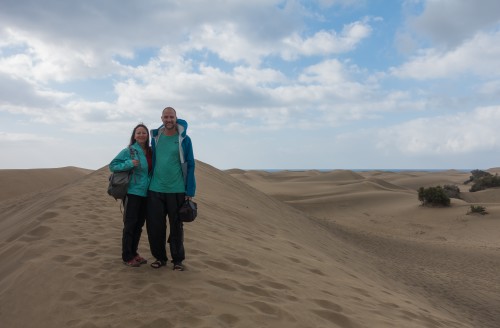 |
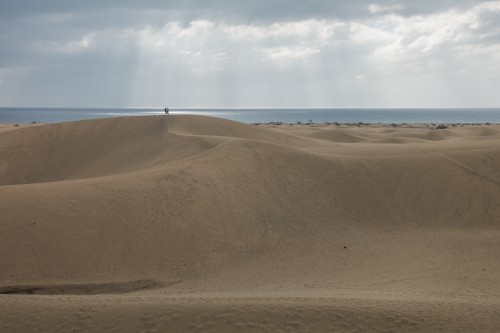 |
Along the drive Guillermo kept us engaged with the explanation of why the island is called “Gran” Canaria, even though it is not the biggest or most populated. We can’t begin to do his story justice, but the short story is that it took by far the longest for the Europeans to conquer, in part because there were only two main groups, both of which were very powerful, as opposed to a number of smaller groups that were easier to pick off, such as on the other islands. He also gave us some history of where people came from. The original Canarians were blonde with light eyes, which was very surprising to the European explorers. There are groups of people (Berbers, which we learned came from the word “Barbarian”) from the Atlas Mountain area in Morocco and Algeria that have light features. Guillermo asked if we recognized the name Zinadine Zidane (the famous French footballer), as he was an example of someone with such a heritage. Without skipping a beat, Justin said “yeah, isn’t his Algerian heritage what Marco Matarazzi said to cause Zidane to headbutt him?” Guillermo was not expecting this, but yes, that’s exactly what happened.
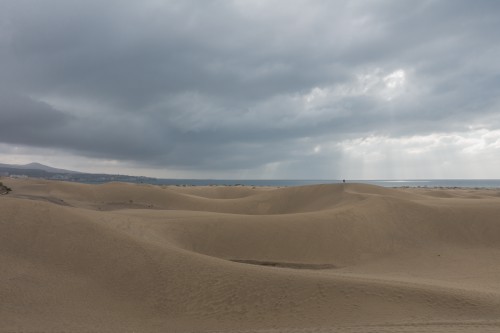 |
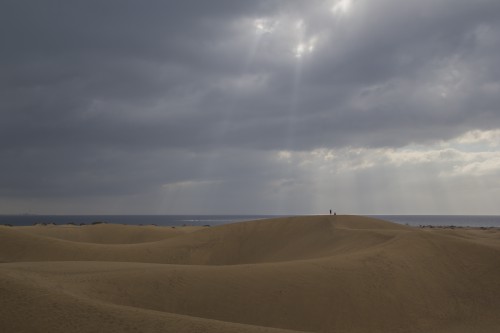 |
One really interesting subject that Guillermo raised with us is that there is no archaeological evidence of any ships, anywhere on the island, so how did the people get here? One common guess is that perhaps the people were convicts or troublemakers or something, where the Romans or others brought people there, dropped them, and then left them. Of course, one would think that once stranded, the people would have said to themselves “hey, why don’t we try to make our own boats to get back?” Then again, after seeing Gran Canaria today, maybe they had no interest in going back to the mountains in the desert of North Africa. As we were arriving in Maspalomas, Guillermo told us about the native Canarians having their own language that was all whistling, where people could literally communicate in the big valleys on the island just by whistling in a particular fashion. The old wives’ tale is that they started this language because the Romans or whomever theoretically stranded the persons on the island cut out their tongues so that the elders could not tell the newborns about where they came from. Who knows?
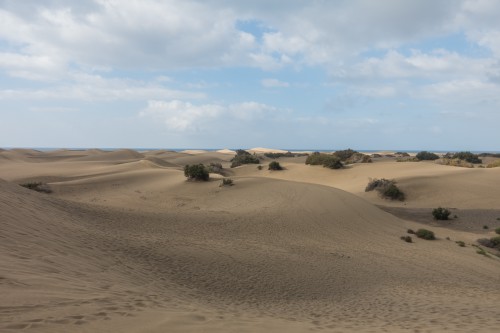 |
 |
It was cloudy in Maspalomas, which is unusual for the area. Gran Canaria, like Tenerife and El Hierro and Madeira, has prevailing winds from the north, so all of the moisture falls on the north side of the island and the south side is normally clear and sunny. Because of this, most of the big tourist sites are on the south sides. We didn’t go to the south of Tenerife, but Alicia indicated it was much more touristy. Guillermo said the same is true for Gran Canaria. We could certainly tell Maspalomas was touristy, as all of the signs were in English, everything was a bar or restaurant or club, and it had a very Waikiki vibe going on. The Canaries are the “Hawaii” of Europe, with everyone fleeing the cold winters of Europe to visit the Canaries and its warm water. That being said, the water is not as warm as Hawaii or the Caribbean, and – likely because of this – the climate is not as tropical.
 |
Guillermo told us that the sand dunes kept getting infringed upon by new hotels until a couple decades ago, but are now protected. There were not very many people out, likely because it was cloudy and there was even a tiny amount of drizzle. While the weather wasn’t normal, it had its benefits, as the sun coming through the clouds was cool, and we had some of the dunes to ourselves. We hung out for maybe 15-20 minutes, walking around and taking photos. Behind us was a big satellite, and Guillermo told us something we had never heard before. Apparently during the space race in the 1960s, NASA had satellites around the globe to communicate with the spacecraft even when the US was on the “backside” of the globe (relative to the spacecraft). These satellites would communicate directly with the spacecraft, and then radio everything back to the US. So when Neil Armstrong first stepped on the moon, a couple people on Gran Canaria heard his famous words a few seconds before the rest of the globe, as it was this specific satellite that was communicating with Apollo.
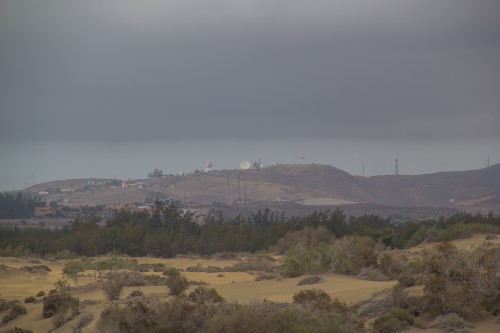 |
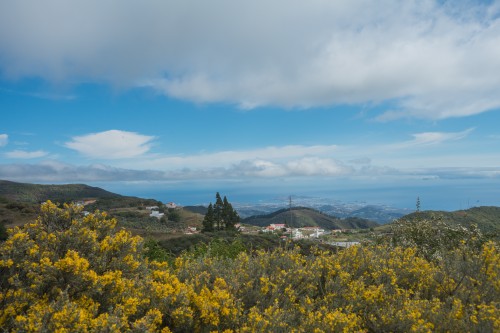 |
Going back to the vehicle, Guillermo heard a specific bird call, and mentioned that he does a lot of tours for birders. There is in fact one rare bird that lives only on Gran Canaria, and birders will come from all over the globe just to try to find it. From Maspalomas we headed back towards the airport, then turned towards the center of the island to go up to the roof. On the drive Guillermo finished the story about how the Spanish conquered Gran Canaria. They came during summer solstice week when the northern and southern kingdoms were on a truce because of the holiday. Since neither big group was expecting any possible warfare, their guards were down, and the Spanish were able to build a fort and establish a base from which they could add reinforcements, and eventually they wore down the Canarians over many years.
 |
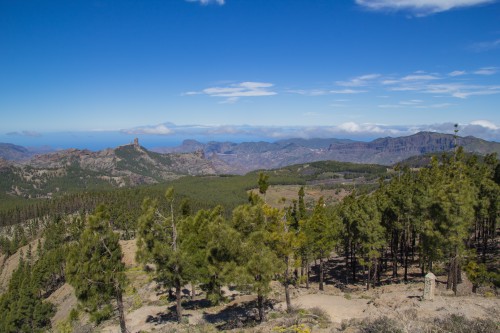 |
On the drive up the mountain Guillermo showed us a big ravine (valley) we’d be going to later. We also, as with Tenerife, went through a bunch of different climactic zones on the way up. About halfway up there were lots of short flowering shrubs, sort of the equivalent to fynbos in the Cape area. Higher still was a forested area. Unlike Tenerife, there were still trees around when we got to the top. Gran Canaria was more like Kauai than Hawaii – instead of a giant volcano, the center of island was missing. Guillermo explained that the island grew very quickly, then there was a pause, then huge explosive eruptions that destroyed the center, and then little burps around the periphery since.
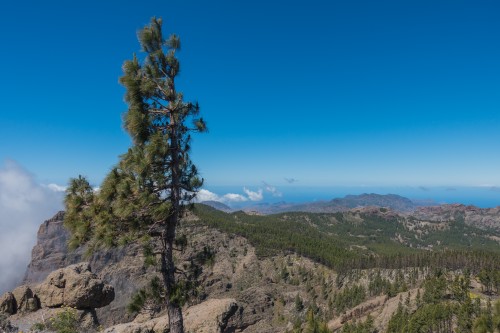 |
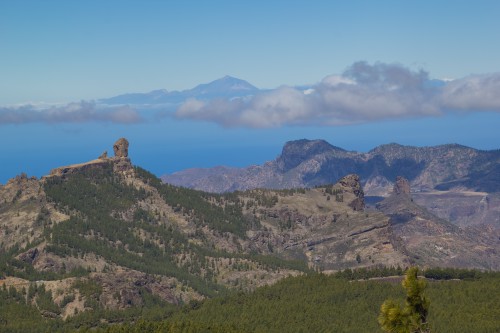 |
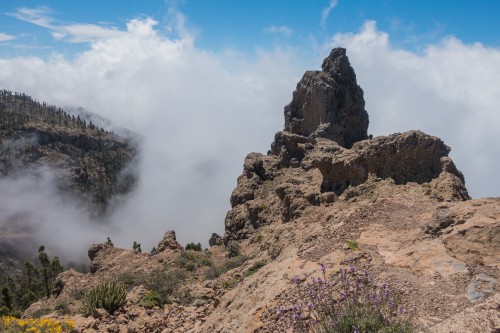 |
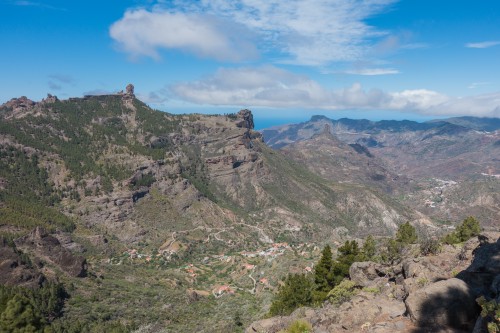 |
 |
It was very windy at the top, from the north. But contrary to the normal patterns, it was clear to the north and cloudy to the south. There were great views of Tenerife (Mt Teide) and the north part of the giant crater that blew itself to bits. We were up at the viewpoint for 5-10 minutes, but the wind was stifling and so we didn’t stay any longer, despite the great view. Guillermo told us a bit about Los Candiles Cave, near Artenara Mountain, that has a bunch of engravings of pubic triangles. Supposedly from the cave there is a good view out over this giant rock which we could see on the western part of the crater rim.
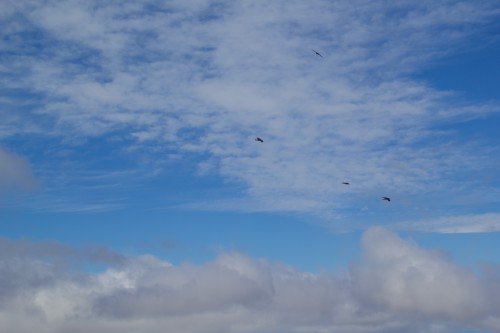 |
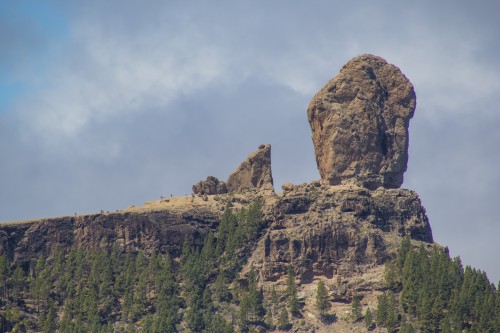 |
 |
 |
Because it was clear to the north, Guillermo audibled and took us to nearby camping area that was on southeast rim of the disintegrated crater. As we drove in he saw one of the large lizards, which was unusual since it is so much colder at the top, but it hid before the two of us could see it. We walked down a bit to the edge of the rim, and footing was a bit slippery since we were wearing sandals for the sand dunes, not walking on pine needles on a hillside. But we made it to the viewpoint in one piece and had great views to the north. Guillermo also pointed out a bunch of people at the base of the giant rock, and with the people as context, we got an idea of exactly how massive this rock was. We also saw literally half of the ravens left on the island. They are making a comeback, but there are remarkably few at the moment. We saw a couple fighting over a pine cone. We also saw some kestrels. We did manage to see the big lizard on the way out, but couldn’t get any good photos of it as it kept moving around to get away from us.
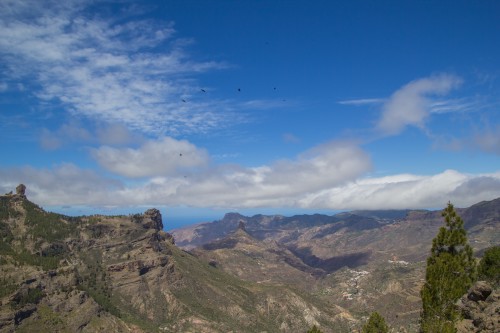 |
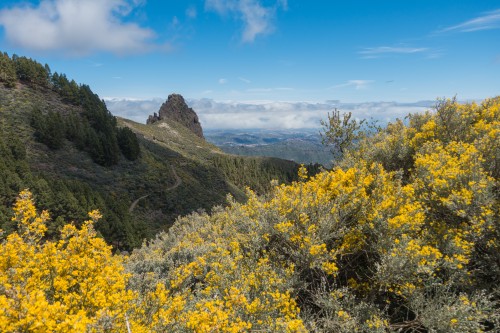 |
We stopped at yet another viewpoint halfway down, with lots of blooming shrubs, another deep crater, and good views out towards the airport and also Las Palmas. There were lots of yellow flowers, but also quite a few purple flowers, which we don’t see too often. On the way down Guillermo told us a crazy story about people living in the caves in Guayadeque. We aren’t going to get this correct, but this was the gist of it. People were worried about their babies having their spirits invaded when the babies slept, prior to baptism. So parents would keep an eye on babies the whole time the babies were asleep. As one can imagine, this makes it near impossible for the parents to get any sleep. So neighbors would cover for each other such that the parents could sleep. These baby-watching parties were pretty boring, so to spice things up people would do these dances. The dance involved naked males using their erect members to try to break fig leaves worn over the crotch of females. Guillermo said there is a documentary with elders telling stories of this – we’ll have to catch this at some point.
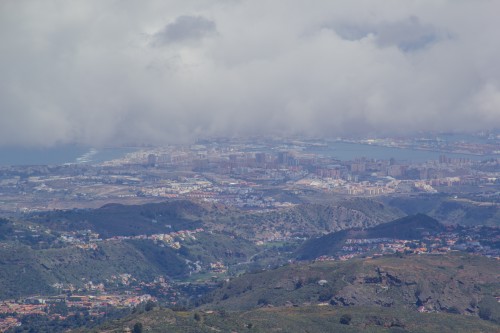 |
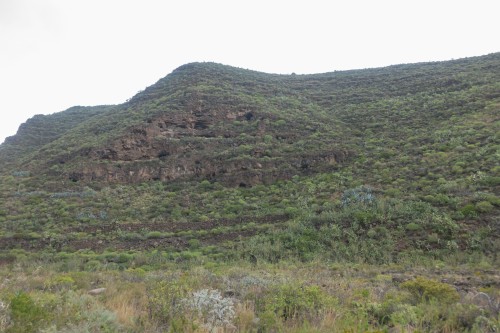 |
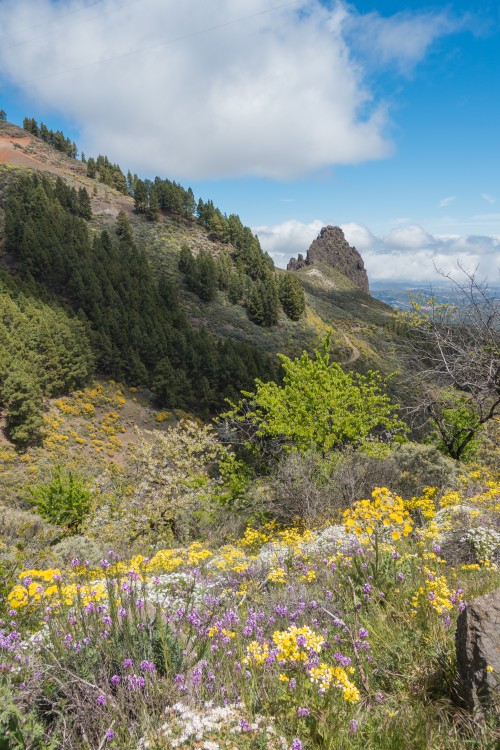 |
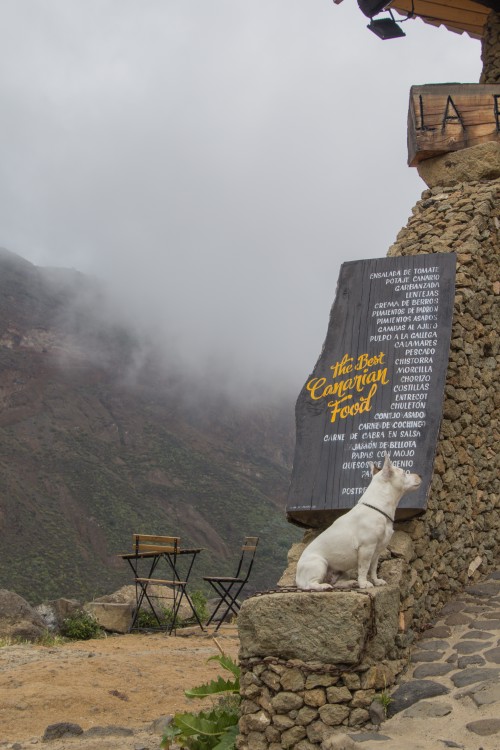 |
It was cloudy in the Guayadeque ravine, but not really raining. There were tons of caves on either side of the valley floor. Interestingly, there were modern houses built into some of these caves, with power, hot water, internet, etc. The ravine was caused by a massive lateral explosion of the volcano. At the end of the road we took some photos, and there was a woman with a restaurant trying to get her dog to sit right out in front of the sign. From here we could see clouds coming in (from the southeast) and being pushed back by the prevailing winds.
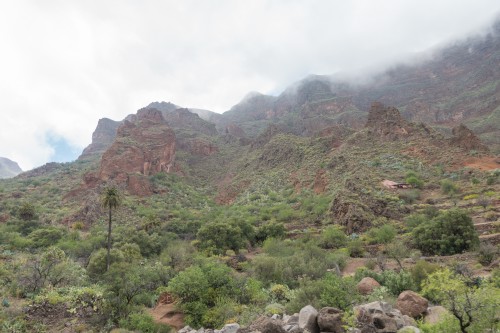 |
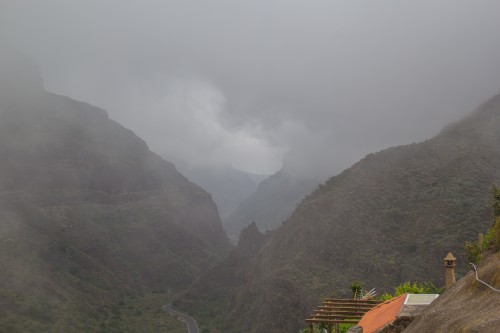 |
After checking out the view for a bit we drove back to the lower part of the ravine, and ate at a restaurant in a cave, Restaurante El Centro. It was a tapas place, and we realized this was our first tapas lunch of the trip. We’d skipped lunch in Madeira and Tenerife, and the lunch in La Restinga on El Hierro had been fish (Crystal) and steak (Justin). We talked through the menu with Guillermo and ordered some fried cheese, bread made with corn flour and anise (it was really good), fried pork, potatoes with orange sauce, padron peppers (like shisito peppers), and morcilla. We also got some of the local wine. We toasted Crystal now having visited 50 countries – Justin was at 49, soon to be 50 as soon as we made it to Morocco. The acoustics inside the restaurant were really interesting, and we made sure to stay quiet so we wouldn’t bother whatever table was in the correct spot to hear our conversation as if we were sitting right next to them. During lunch, as with the days before, we discussed similarities between Hawaii and the Canaries.
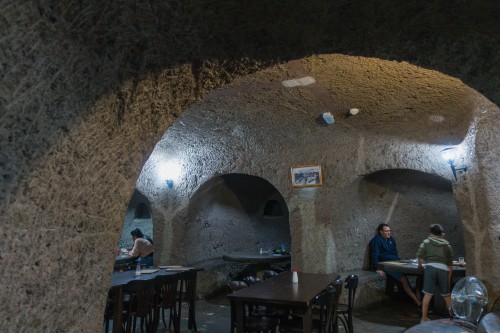 |
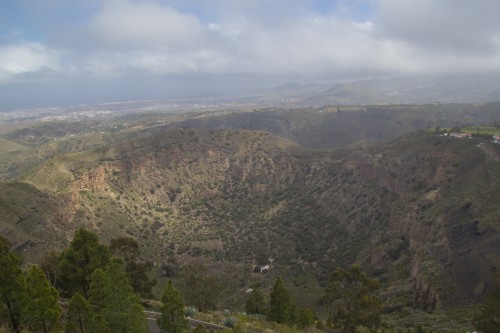 |
Heading back towards the east coast after lunch we saw a kestrel that Guillermo pointed out. We headed back up the east coast and went to the Bandama Crater, close to Las Palmas, site of the most recent eruption (2000 years ago). There was a windy road circling up the mountain. As we were heading up the road Guillermo said “I’d like you to close your eyes now, please” so that we could be surprised to see the big crater for the first time when we got to the top. We had driven up one of two twin volcanoes – the one we were on had remained, but the twin had blown itself up and left a large, almost perfectly circular crater. It was cloudy and misty, but the views were still quite good, particularly to the east. The views to the north were impacted, but we’d seen the north quite well from highest viewpoint, Pico de las Nieves. Guillermo told us that there is an 86 year old man that walks down into crater every morning and back up every night – we’d be ecstatic if we were doing something like this at 86.
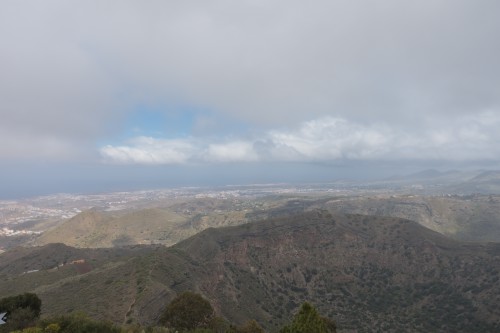 |
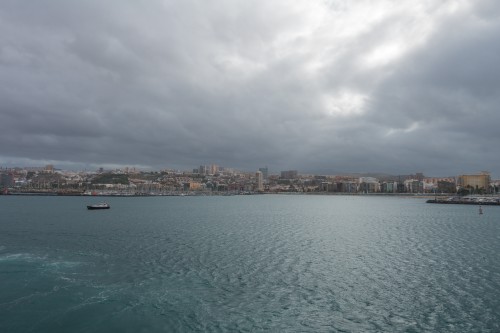 |
We headed back down and back towards the ship. As Guillermo had promised, he aimed for 4pm, figuring we’d be done at 5, and we got back to the port just after 5. He was kind enough to send us some stuff about Fuerteventura and a possible guide. He also told us our Lanzarote guide might be able to help out, since the islands are so close. He also recommended that we see Jameos del Agua on Lanzarote. We thanked him profusely, then walked back to the boat, getting back on around 5:10. While we weren’t the “winners” today, we still felt we were the winners for everything we saw, did, and learned. As with the day before, we went into the club on 5 to write down stuff before we forgot, then listened to Claudio’s talk about what we might see the next day.
Just after 6 we changed, then went up to get some mango daquiris with Matias. We spoke for a bit about the Champions League – Matias loves soccer. This put in our mind the possibility of watching the Champions League in Barcelona, if they were still in the tournament and happened to be playing whilst we were there. The Patio Bar was much emptier than a couple days prior. Because of this, we had more time to chat and less concern about asking for drinks beyond the normal. We asked Matias for what we labeled a “San Diego” margarita – 3 parts tequila, 0.5 parts cointreau, 0.5 parts fresh lime juice. It’s so much better than anything with sweet and sour or any type of syrup.
We sat in Jose’s section, and were alone in that section for quite a while. It was a repeat of one of the menus we’d seen earlier, but that wasn’t an issue since we liked this one. Crystal got some Prosciutto wrapped asparagus whilst Justin got pasta, and for our mains we both got the ribeye. Jose was able to grab some pisco and got Matias to make Justin a chilcano as well – it was excellent. We left right as a table of 8 Americans were going to sit down right next to us – we were done anyway, but we didn’t need to be the 9th and 10th wheel.
After dinner we went up to 10, and there were lots of the same people as last night. There was the German/Australian couple, a US Midwest couple, a British couple, us, and a rotating cast of characters. Helder is always on the edge of dry humor, to the point we can’t really tell when he’s being sarcastic and when he’s not. There was a British patron who was on the edge of funny and just being a jerk, and we couldn’t tell if he was trying to be funny or if he was just sloshed. He certainly had command of the room, for better or worse, constantly saying “Shut up your face” when he was surprised by something. Helder stepped out for a bit, and Matheus (from Brazil, not to be confused with Matias from Peru) took over for 5 minutes. The British was guy giving him grief, and said “you speak quite good English” in a way that didn’t seem particularly flattering. Justin said “so do you” but with a slight smile so as to not be obvious. His wife seemed to appreciate someone putting her husband in his place. The scene should have been a movie, as everyone was cracking jokes – some of the folks said the entertainment was better than the shows downstairs, since it was interactive. We stayed for about 2 hours, then headed down where Braddah Iz was playing on the TV when we walked in (Melanie would turn on TV as part of the turndown service), so we listened to him as we dozed off for the night. It seemed fitting in the European Hawaii.
| Previous Day |